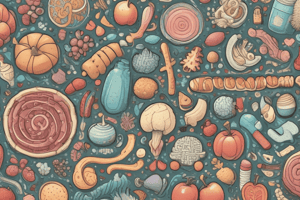Podcast
Questions and Answers
What is a primary function of chondroitin sulfate?
What is a primary function of chondroitin sulfate?
- Improving corneal transparency
- Enhancing bacterial infection spread
- Promoting hemophilia recovery
- Treating osteoarthritis (correct)
Which of the following statements is true regarding hyaluronidase?
Which of the following statements is true regarding hyaluronidase?
- It hydrolyzes lipids in the bloodstream.
- It aids in the fertilization process. (correct)
- It promotes corneal clarity.
- It enhances the action of heparin only.
What is one of the effects of mucopolysaccharidosis (MPS)?
What is one of the effects of mucopolysaccharidosis (MPS)?
- Accumulation of GAGs in various tissues (correct)
- Enhanced cognitive abilities
- Decreased organ size
- Increased flexibility in joints
What role does dermatan sulfate play in the body?
What role does dermatan sulfate play in the body?
What is a function of heparan sulfate proteoglycan?
What is a function of heparan sulfate proteoglycan?
What is a characteristic clinical manifestation of mucopolysaccharidosis?
What is a characteristic clinical manifestation of mucopolysaccharidosis?
What characterizes enantiomers in sugars?
What characterizes enantiomers in sugars?
Which of the following pairs represent an aldose and its corresponding ketose?
Which of the following pairs represent an aldose and its corresponding ketose?
What is the cyclic form of D-glucose that is most common in nature?
What is the cyclic form of D-glucose that is most common in nature?
In the Haworth formula, how are groups that are on the right side of the straight formula positioned?
In the Haworth formula, how are groups that are on the right side of the straight formula positioned?
What is a key characteristic of reducing disaccharides?
What is a key characteristic of reducing disaccharides?
What type of sugar is ribose, and what significant roles does it play?
What type of sugar is ribose, and what significant roles does it play?
Which enzyme catalyzes the hydrolysis of maltose?
Which enzyme catalyzes the hydrolysis of maltose?
Which of the following correctly describes non-reducing disaccharides?
Which of the following correctly describes non-reducing disaccharides?
Which carbon atom is referred to as the anomeric carbon in the cyclic structure of sugars?
Which carbon atom is referred to as the anomeric carbon in the cyclic structure of sugars?
How is the furanose form of D-fructose characterized in terms of carbon cyclization?
How is the furanose form of D-fructose characterized in terms of carbon cyclization?
What is the linkage type of lactose?
What is the linkage type of lactose?
In which food source is sucrose predominantly found?
In which food source is sucrose predominantly found?
What distinguishes the α form of a sugar from the β form regarding the anomeric carbon?
What distinguishes the α form of a sugar from the β form regarding the anomeric carbon?
Which of the following pairs represents the ring structures formed by D-glucose?
Which of the following pairs represents the ring structures formed by D-glucose?
Which of the following disaccharides has an a1-6 glucosidic linkage?
Which of the following disaccharides has an a1-6 glucosidic linkage?
What happens to the reducing ability of disaccharides when their anomeric carbons participate in glycosidic linkages?
What happens to the reducing ability of disaccharides when their anomeric carbons participate in glycosidic linkages?
Which sugar is a product of sucrose hydrolysis?
Which sugar is a product of sucrose hydrolysis?
What distinguishes non-reducing disaccharides from reducing counterparts?
What distinguishes non-reducing disaccharides from reducing counterparts?
Which of the following is true about maltose?
Which of the following is true about maltose?
What is the primary composition percentage of carbohydrates in proteoglycans?
What is the primary composition percentage of carbohydrates in proteoglycans?
Which GAG is known for forming hydrated gels that have a filtering effect on large molecules in the extracellular matrix?
Which GAG is known for forming hydrated gels that have a filtering effect on large molecules in the extracellular matrix?
In what context is hyaluronic acid utilized in rheumatology?
In what context is hyaluronic acid utilized in rheumatology?
Which GAG is primarily involved in the compressibility and resilience of cartilage?
Which GAG is primarily involved in the compressibility and resilience of cartilage?
What is the primary site of action for hyaluronic acid in the body?
What is the primary site of action for hyaluronic acid in the body?
Which of the following roles is NOT associated with negatively charged GAGs?
Which of the following roles is NOT associated with negatively charged GAGs?
Which structural feature distinguishes proteoglycans from other molecules?
Which structural feature distinguishes proteoglycans from other molecules?
What impact does hyaluronic acid have on the appearance of skin as one ages?
What impact does hyaluronic acid have on the appearance of skin as one ages?
In the context of cartilage, what is an essential component that contributes to its structure and function?
In the context of cartilage, what is an essential component that contributes to its structure and function?
How do GAGs primarily influence water movement in the extracellular matrix?
How do GAGs primarily influence water movement in the extracellular matrix?
Which of the following statements about homopolysaccharides is correct?
Which of the following statements about homopolysaccharides is correct?
What differentiates glycogen from amylopectin?
What differentiates glycogen from amylopectin?
Why is cellulose not digested by humans?
Why is cellulose not digested by humans?
What is the primary role of cellulose in the human diet?
What is the primary role of cellulose in the human diet?
Which statement accurately describes glycosaminoglycans (GAGs)?
Which statement accurately describes glycosaminoglycans (GAGs)?
What fraction of starch granules is made up of amylose?
What fraction of starch granules is made up of amylose?
Which polysaccharide serves as a storage form of carbohydrates in animals?
Which polysaccharide serves as a storage form of carbohydrates in animals?
Which of the following features distinguishes amylose from amylopectin?
Which of the following features distinguishes amylose from amylopectin?
What is the significance of the type of linkages in cellulose?
What is the significance of the type of linkages in cellulose?
Which of the following is true regarding the hydrolysis of starch?
Which of the following is true regarding the hydrolysis of starch?
Flashcards are hidden until you start studying
Study Notes
Monosaccharides
- Monosaccharides are simple sugars, the basic building blocks of carbohydrates.
- Examples: Glucose, fructose, galactose, ribose, deoxyribose.
- Isomers: Molecules with the same molecular formula but different structures.
- Enantiomers: Mirror images of each other (D and L forms).
- Example: D-glyceraldehyde and L-glyceraldehyde.
- Aldose-ketose isomers: Differ in the functional group.
- Aldoses have an aldehyde group (CHO).
- Ketoses have a ketone group (C=O).
- Enantiomers: Mirror images of each other (D and L forms).
- Ring structures: Pentoses and hexoses can form cyclic structures.
- Furanose: 4-carbon ring (e.g., ribose).
- Pyranose: 5-carbon ring (e.g., glucose).
- Haworth projection: Represents the cyclic structure.
- Groups on the left in the straight-chain form are written upward.
- Groups on the right in the straight-chain form are written downward.
- Anomeric carbon: The carbonyl carbon becomes asymmetric in the cyclic form.
- α form: OH is on the right of the anomeric carbon.
- β form: OH is on the left of the anomeric carbon.
- Examples:
- D-Glucose: exists in both furanose and pyranose forms.
- D-Fructose: exists in both furanose and pyranose forms.
- Importance: Monosaccharides are essential for energy production, structural support, and biosynthesis.
Disaccharides
- Disaccharides consist of two monosaccharides linked by a glycosidic bond.
- Reducing disaccharides: Contain a free anomeric carbon.
- Present in α and β forms.
- Examples: Maltose, isomaltose, lactose.
- Non-reducing disaccharides: Both anomeric carbons are involved in the glycosidic bond.
- Example: Sucrose.
- Does not have α or β forms.
Polysaccharides
- Polysaccharides are polymers of many monosaccharides.
- Homopolysaccharides: Contain only one type of monosaccharide.
- Heteropolysaccharides: Contain more than one type of monosaccharide.
Homopolysaccharides
- Glucans: Formed of D-glucose units.
- Starch:
- Storage form of carbohydrates in plants.
- Amylose: Linear, α1-4 linkages.
- Amylopectin: Branched, α1-4 and α1-6 linkages.
- Glycogen: Storage form of carbohydrates in animals.
- Highly branched, similar to amylopectin.
- Cellulose:
- Linear polymer of β, D-glucose, β1-4 linkages.
- Found in plant cell walls.
- Not digestible by humans due to β1-4 linkages.
- Important for dietary fiber.
- Starch:
- Fructans: Formed of D-fructose units.
- Inulin: Found in plants, used for kidney function tests.
Heteropolysaccharides
- Glycosaminoglycans (GAGs):
- Unbranched, long chains of heteropolysaccharides.
- Usually consist of uronic acid and amino sugar.
- Examples:
- Hyaluronic acid: Sulfate free, found in connective tissue, synovial fluid, and vitreous humor.
- Chondroitin sulfate: Most abundant GAG in cartilage, tendons, and ligaments.
- Dermatan sulfate: Found in skin, blood vessels, and heart valves.
- Keratan sulfate: Important for corneal transparency.
- Heparin: Anticoagulant, releases lipoprotein lipase.
- Heparan sulfate: Involved in cell-cell interaction and membrane receptors.
- Proteoglycans:
- GAGs covalently linked to a protein core.
- Found in the extracellular matrix.
- Functions:
- Attract water, forming hydrated gel.
- Provide structural support and lubrication.
- Control permeability of the extracellular matrix.
- Examples:
- Aggrecan: Major proteoglycan in cartilage.
- Hyaluronic acid proteoglycan: Important for skin elasticity, joint lubrication, and eye health.
Mucopolysaccharidoses (MPS)
- Group of genetic disorders caused by defects in lysosomal enzymes responsible for GAG breakdown.
- Symptoms:
- Bone abnormalities (dwarfism, joint stiffness).
- Enlarged organs (liver, spleen).
- Mental retardation.
- Thickened skin.
- Heart disease.
- Recurrent respiratory tract infections.
Studying That Suits You
Use AI to generate personalized quizzes and flashcards to suit your learning preferences.




